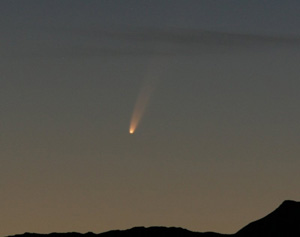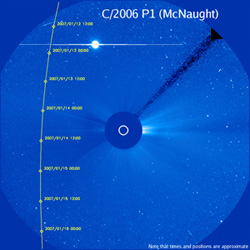Due to its proximity to the sun, it can be seen before and during sunrise, as well as during sunset. The image was taken from Hammerfest, Norway, on January 6, 2007 by amateur photographer Roger Johansen and published on the NASA website.

If you watch the morning or evening sky, and you have a field of vision and a clear sky in the direction of the horizon, you can actually see a bright one with a respectable tail.
Instructions: At sunrise go outside and look east. Use binoculars, scan the horizon. The comet is centered south of the area from which the sun rises.
At sunset look west, use binoculars, scan the horizon. The comet is low in the sky, to the right of Venus. It is essential to go where there is clear visibility.
The comet is C/2006 P1 and thanks to its brightness it was also named Comet McNaught. It was discovered on August 7 by successful comet explorer Rob McNaught. At the time of discovery, the comet was a very pale object, but his prediction was that at the perihelion point - the closest point to the sun, it would be at a distance of 0.17 astronomical units (an astronomical unit is the average distance between the Earth and the Sun, about 150 million kilometers). This fact indicated that the object has the potential to become very bright. No one knows what it will look like when it reaches the closest point to the sun. This is where a device called LASCO on the SOHO satellite that can observe comets approaching the Sun comes to our aid. The comet should enter LASCO's field of view during the next week. When the SOHO cameras photograph the comet, NASA will upload the image to the SOHO website.
 In the picture - the predicted trajectory of the comet through the field of view of the LASCO coronagraph in the Soho spacecraft. The comet will appear in the field of view on January 12th (today) at around 10 GMT (12:00 noon our time), a few hours before the closest point in the upper left part of the image and will move almost straight down, leaving the left side of the field of view on January 16th At 03:00 GMT (0500 Israel time).
In the picture - the predicted trajectory of the comet through the field of view of the LASCO coronagraph in the Soho spacecraft. The comet will appear in the field of view on January 12th (today) at around 10 GMT (12:00 noon our time), a few hours before the closest point in the upper left part of the image and will move almost straight down, leaving the left side of the field of view on January 16th At 03:00 GMT (0500 Israel time).
It is not yet known what the maximum brightness of the comet will be. Estimates initially ranged from +2.1 (about the brightness of the North Star) to minus 8.8 - 40 times brighter than the North Star, more than Venus. The more accurate estimates speak of a brightness of between 0 and minus 1. It is also possible that we will reach a magnitude of minus 2 to minus 3, when the comet reaches the field of view of LASCO. This means that it will be brighter than Comet NEAT and Comet Mechholz which were among the brightest comets in the sky.

3 תגובות
Apparently he fled a little south and that's why you don't see him in Israel.
And besides, it's nice to hear about surfers in interesting places.
Tonight I saw the comet from Knut in Cape Town. We sat on the beach with hundreds of other people and watched McNutt. It was amazing. - Also near the moon there was another sparkling and amazing light and it was the star Venus. –
We had an amazing experience between McNutt and Venus.
All the best and good luck to those looking for McNutt. Come to Cape Town.
Ilana
I have been trying to locate our friend from Knught for the past three days including before and at sunrise but without success.
If anyone has seen it, give directions (a few "fingers" to the right or left of the sun and above the horizon, etc.)
This morning, Sunday, visibility was good and I checked with binoculars according to the general instructions at sunrise and again without success...
Who saw who knew?